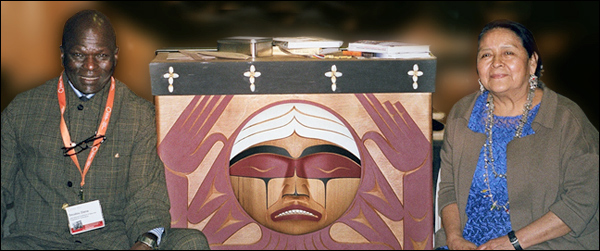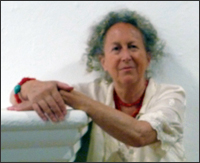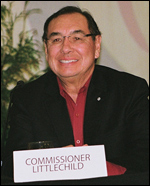|
SILENT GENOCIDE
INDIGENOUS PEOPLES: THE RIGHT TO LIFE
International Day for the Elimination of
Racial Discrimination
March 21, 2011
 |
Truth and Reconciliation Commission of Canada (TRC) -
Sharing Truth: Creating a National Research Centre on
Residential Schools, March 1-3, 2011, Vancouver, Canada
International Speakers, L-R, Doudou Diene, UN Special
Rapporteur for contemporary forms of racism, racial
discrimination, xenophobia and related intolerance
(2002-2008) and Otilia Lux de Coti, member of Congress of
the Republic of Guatemala, vice-president of the United
Nations Permanent Forum on Indigenous Issues (2002-2007).
The TRC Bentwood Box, carved by Coast Salish artist Luke
Marston, is a lasting tribute to all Residential School
survivors and reflects the strength and resilience of
residential school survivors and their descendants, and
honours those survivors who are no longer living. |
A PERSONAL VISION ON SILENT GENOCIDE
NATALIE DRACHE
Editor/Publisher
Dialogue Between Nations |
For two
decades, I have been listening to Indigenous peoples from
all regions of the world attempting to bring attention to
what is happening to them in their communities and outside
of their communities: forced relocation; the scarring and
appropriation of their lands; the mutilation of the air, the
seas, rivers, earth, plants and animals, ourselves and all
our relations, disrespecting warnings, prophesies,
Indigenous true history, language and traditional knowledge.
The violent removal of children from their parents and the
abuses played out upon them; the annihilation of families
caught in the cross-fire of wars that are not of their own
making; and many other violations of individuals whose right
to exist is not respected.
I recently had the opportunity of attending Sharing Truth -
Creating a National Research Centre Forum on Residential
Schools, an initiative of the
Truth and Reconciliation
Commission of Canada. A number of international guest
speakers from several continents were invited to share their
knowledge with regards to the preservation of survivor
experiences. An evaluation of best practices is intended to
form the basis towards Establishing a National Memory, which
will contribute to the healing of the trauma experienced by
a large number of Aboriginal people and their communities,
as well as providing a living memorial to be shared with all
Canadians. Truth sharing circles were an integral component
of the forum, allowing survivors who chose to speak, an
opportunity to transform their sorrow and memories.
All this unexpectedly touched something that has been at the
core of my own emotional imbalance as I attempt to come to
grips with a recurrent theme, one which twists my soul,
leaves my throat dry, and heightens an internal shaking that
is the current of my most intimate fear. Immersed in the
generosity of the moment, I crossed over from being a
witness-by-profession and entered the circle of pain
alongside aboriginal survivors: forgotten children now being
remembered. When the feather and a stone was handed to me, I
offered up an apology for not knowing what had happened and
a second apology for not speaking out when I did know of the
existence of the residential schools. But more than that, it
was the first time that I no longer denied that lifelong
trauma which passes from one generation to the next, through
one century into another.
There are situations, past, present and ongoing of such
distress, which if widely considered, fall into the
definition of genocide. In some cases, determined acts of
genocide are localized, pre-meditated and legislated. In
other instances, genocide is the result of an acquired
attitude, very quiet and dispersed, so silent and almost
casually accepted, that the disappearances and deaths of
Indigenous individuals one by one, goes unnoticed. A family
disinherited, brutalized here, or there, living in fear and
trauma.
If one were to access reports on the number of Indigenous
people around the world suffering on a casualty by casualty
basis, there is no doubt in my mind we are talking about
millions of individuals caught up in a devastating holocaust
which continues to evolve, and to which there is a very
disturbing and almost passive lack of awareness.

Natalie Drache,
Canada
Editor/Publisher, Dialogue Between Nations
Delegate, Sharing Truth: Creating a National
Research Centre on Residential Schools |
Saying this, I have come to the conclusion that there is a
consistent and systemic movement of global proportions
consumed by an irresponsible inertia of ignorance turning
into subtle and invisible violence, which could potentially
lead to the elimination or total assimilation of Indigenous
peoples throughout the world. I call this horrific vision
Silent Genocide.
Because the scale of this movement is rarely visible beyond
immediate rights abuses, and the larger framework is almost
never given a context beyond local communities and national
borders, the scope of this tragedy is not readily apparent.
The accumulation of multiple violations worldwide is rarely
investigated, nor even considered by local media and justice
systems.
And in almost all seemingly invisible or non-violent cases,
the general public remains silent, either in ignorance,
complicity or denial, citizens whose moral response to the
idea that genocide attributed to them is insulting. Of
course, this might be an enormous and mistaken
generalization on my part as there are people of good faith,
compassion and trust who are working with and for Indigenous
people in a process of reconciliation and justice. This
attests to the fact that accountability rests with each
citizen in urging their country's government to comply and
act on the ground in accord with human rights and
humanitarian law. What is a country if it isn't you and I?
However, if my initial observation regarding the tragedy of
silent genocide, based upon factual evidence, including
testimony, memory and oral history is found to be wrong,
then I would hope that the current situation of Indigenous
Peoples and the potentiality of a uniquely different
relationship based upon the recognition and implementation of
their inherent rights, would eventually, over several
generations, lead to respect for Indigenous
self-determination comfortably co-existing on equal terms
with other societies.
 |
Chief Wilton
Littlechild, Commissioner
Truth and Reconciliation Commission of Canada.
Independent expert, member of the United Nations
Permanent Forum
on Indigenous Issues, 2002 - 2007 |
The possibility of a peaceful relationship of Indigenous
nations within nation states, and vice-versa: nation states
respecting the traditional territories of Indigenous
peoples, nations, tribes and clans, and the realization of
such a constructive and positive vision, would most
certainly contribute to the stability and survival of our
shared modern world.
It is suggested in a not entirely universal concept of
evolving human rights, and within the definition of a
so-called civilized society, the current trauma of millions
of Indigenous individuals can, on one hand, be healed
through the elimination of racism, racial discrimination,
xenophobia and related intolerance. I see it more like the
elimination of the causes of the above. And I am speaking
here about a profound individual social, cultural and
political will leading to personal and collective
transformation.
Between all of us, we have some commonalities: many of us
carry some joys but all of us carry some scars. No one is
completely immune to pain in its directness and in its many
mental and psychological manifestations. Yet, we also have
the capacity of denial when it suits us as we become
de-sensitized to the pain in others or inflicted upon others
in a clash of worldviews and xenophobia.
This amazing ability to open up or/and close down on our
humanity, as easily as breathing in or breathing out, acts
as a form of protection and survival. It is often motivated
by the dichotomy of perception, as well as the multiplicity
of misconceptions we create on so many levels that impact
one another in accepting a friend or eliminating an enemy.
Who shall live and who shall die in a world which we
seemingly try to control through personal or collective
judgments?
As a child born in Vancouver, Canada on March 21, 1942,
enjoying the seasonal magic of the first day of spring, to
later in life discovering that because of a massacre in
Sharpeville, South Africa in 1960, this precious day of mine
lost its innocence. Or perhaps it was I who lost my
innocence. The United Nations chose to commemorate that
tragedy in Sharpeville by naming the 21st of March, the
International Day for the Elimination of Racial
Discrimination and I found my birthright catapulting down a
path over which I had no control. I can only hope that some
splinter of sacred intuition envelopes and protects me/all
of us like a parachute softly floating against free fall,
towards a world illuminated within a brilliant flash of
insight.
There is a journalistic ethic to be respected here, but I
believe it has been betrayed by a broken heart.
So I have to ask myself, and you also, why is it so
difficult, so challenging to embrace each other's distinct
and diverse right to life? Is it not possible to turn around
the devastating wave of silent genocide as perpetrated on
many of the nearly 400 million Indigenous people living in
our world today?
To all of you, survivors, witnesses and friends: our
humanity is on the table for debate and dialogue. Our
humanity is up for grabs. And so is our compassion. And our
silence.
Natalie Drache
Editor/Publisher
Dialogue Between Nations

Truth and Reconciliation
Commission of Canada
L-R Commissioner Marie Wilson, Commissioner Justice
Murray Sinclair,
Commissioner Chief Wilton Littlechild
TRUTH AND RECONCILIATION COMMISSION OF CANADA
COMMISSION DE VERITE ET RECONCILIATION DU CANADA
|
The truth telling and reconciliation process as part
of an overall holistic and comprehensive response to
the Indian Residential School legacy is a sincere
indication and acknowledgement of the injustices and
harms experienced by Aboriginal people and the need
for continued healing. The Truth and Reconciliation
Commission will build upon the Statement of
Reconciliation dated January 7,1998 and the
principles developed by the Working Group on Truth
and Reconciliation and of the Exploratory Dialogues
(1998-1999).
Le processus de vérité et de réconciliation, qui
s'inscrit dans une réponse holistique et globale aux
séquelles des pensionnats indiens, est une
indication et une reconnaissance sincères de
l'injustice et des torts causés aux Autochtones, de
même que du besoin de poursuivre la guérison. La
Commission de vérité et de réconciliation
s'inspirera de la Déclaration de réconciliation du 7
janvier 1998 et sur les principes établis par le
Groupe de travail sur la vérité et la réconciliation
et pendant les Dialogues exploratoires de 1998-1999. |
|
|
About
DBN |
Silent Genocide |
Vision |
Relationships |
History
|
Español/Spanish
|